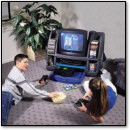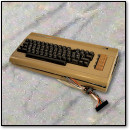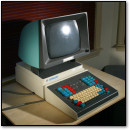January 12th, 2009 by Benj Edwards
 Scott Wolf fans rejoice!
Scott Wolf fans rejoice!
In the early ’90s, I recall being excited when I heard that a Double Dragon movie was in the works. But after that, the film kinda fell off the radar until I ran across it in a video rental store. I never did rent it, but I’m guessing it was pretty terrible. Am I right?
[ From Electronic Gaming Monthly, November 1994 ]
Discussion topic of the week: What’s the best video game movie movie based on a video game of all time?
If you use this image on your site, please support “Retro Scan of the Week” by giving us obvious credit for the original scan and entry. Thanks.
Posted in Gaming History, Regular Features, Retro Scan of the Week, Retrogaming | 41 Comments »
January 7th, 2009 by Benj Edwards
 In Memoriam: EGM (1989-2009), American video game magazine par excellence.
In Memoriam: EGM (1989-2009), American video game magazine par excellence.
As far as I can recall, this is the first issue of Electronic Gaming Monthly I ever bought. I spotted it on a newsstand in a grocery store and begged my mom to buy it for me. Over the next few months of 1993, I bought each new issue from the same source until I convinced my parents that it would be cheaper just to subscribe. So they signed me up, and I’ve been a subscriber to EGM ever since.
Until now. Troubled publisher Ziff-Davis — owner of the 1UP Network and EGM — recently announced the sale of its 1UP property to UGO Entertainment. Sadly, EGM isn’t going along for the ride, but is instead shutting down. January 2009 will be the last issue of EGM in print.
Prior to discovering EGM, my only exposure to video game magazines had been Nintendo Power, the official Nintendo-sanctioned magazine devoted only to Nintendo products. As a publication, Nintendo Power spoke with a sterile, self-censoring voice that was low on speculation and high on propaganda. In contrast, EGM, with its edgy style, gossip column, international coverage, and devotion to multiple platforms (including arcade! — that blew my young mind), opened up a whole new side of the video game industry to me and ignited a passion for the field that persists to this day.

As a writing professional, EGM’s closure stings for reasons beyond simple fandom. Since writing for 1UP.com and visiting EGM’s offices in early 2008, I’ve been fortunate enough to befriend a number of EGM’s editors and staff. As news goes around that over 30 employees’ jobs fell victim to the shakeup, I find myself wincing and hoping the best for all of my colleagues in writing and publishing. Those that met the unsparing axe of nickel-and-dime economics will likely find new jobs elsewhere in time — hopefully sooner rather than later. Until then, I wish them the best of luck, and I’d like to thank EGM’s staff (past and present) for twenty years of incredible, inspiring work.
Posted in Gaming History, Memorials, News & Current Events, Regular Features, Retrogaming | 22 Comments »
January 5th, 2009 by Benj Edwards
 Click above to see the full advertisement
Click above to see the full advertisement
This ad for Tech-Sketch’s Paint-N-Sketch Level II brings back memories. My first encounter with computer art came courtesy of KoalaPaint and the KoalaPad tablet on the Atari 800. Later, I fell in love with MousePaint on my family’s Apple IIc. Using the mouse and creating shapes on the screen was a magical experience, and I regularly begged my father to boot it up for me so I could doodle around in four glorious colors. Because of the program’s title, I was convinced it had something to do with Mickey Mouse.
Not too long after, my dad sold the Apple IIc, and I lacked an outlet for computer art until he bought a Macintosh SE in 1987. But that’s another story all together. Now it’s your turn.
[ From Electronic Games, December 1983. ]
Discussion topic of the week: Tell us about your first computer art experience. What computer and software did you use?
If you use this image on your site, please support “Retro Scan of the Week” by giving us obvious credit for the original scan and entry. Thanks.
Posted in Computer History, Macintosh, Regular Features, Retro Scan of the Week, Technology Commentary, Vintage Computing | 9 Comments »
January 4th, 2009 by Benj Edwards

I should be ashamed of myself. I do so much vintage stuff every week, but I’m usually too lazy to tell you guys about it — and I run a blog called Vintage Computing and Gaming. Well, maybe I can do more quick updates on my activities in the future. Here’s the first.
A few months ago, I visited a family friend’s house. She was cleaning out her attic, and I had long since promised to help her get rid of the numerous dusty computers her late husband had collected.
I came home with seven machines, including an Apple IIc and an old Compaq bearing a Post-It Note warning: “Do not get on this computer.” The note backfired, of course, as it insured that I would be getting on it post-haste.
Once atop the slumbering beast — some five inches off the ground — I booted the machine. Therein, I found a sluggish, hobbled-by-its-own-nature install of Windows ME and no less than 86 virii (this is not an exaggeration) intertwined with every facet of the operating system. As per my promise to the former owner, I formatted the drive with extreme prejudice.
 Chief among the other spoils were a NES Action Set in a near-mint box; the aforementioned Apple IIc’s original box with all documentation; an Apple IIc color monitor and monitor stand, both in box; various boxed Apple II and PC software; a box; six PC clones of various vintage between an AT-class machine and Pentium stuff (no boxes to be seen); and an awesome, non-boxy Model 500 rotary telephone in stylish red and black.
Chief among the other spoils were a NES Action Set in a near-mint box; the aforementioned Apple IIc’s original box with all documentation; an Apple IIc color monitor and monitor stand, both in box; various boxed Apple II and PC software; a box; six PC clones of various vintage between an AT-class machine and Pentium stuff (no boxes to be seen); and an awesome, non-boxy Model 500 rotary telephone in stylish red and black.
Above all else, the equipment carried with it a priceless nostalgic element: I had watched my brother’s best friend use most of these items when I was a kid, so it was very familiar to me.
What you see in the back of the truck above would have met death-by-dumpster had I not gallantly rushed in to save it. Of course, now it’s cluttering up my house instead of hers. Despite the nostalgia rush, I’m starting to think our family friend got the better end of the deal.
Posted in Collecting, Collecting, Computer History, Gaming History, News & Current Events, Retrogaming, Vintage Computing | 13 Comments »
December 29th, 2008 by Benj Edwards
 Ah yes; a worm pun.
Ah yes; a worm pun.
Around the turn of the 1990s, “WORM” (Write Once Read Many) became a common computer industry buzz-word for a new mass-storage concept. Numerous companies released their own WORM drives that used proprietary forms of optical media, most of which were incompatible with other WORM drives. Seen here is such an attempt: a curious “Optical Card” from Canon that obviously didn’t achieve widespread usage. According to the ad, it stored two megabytes of data on an optical layer that could be written once and never changed — much like a CD-R, but without the spinning disc.
Cursory Google searches reveal that the Canon Optical Card eventually saw limited trials as an identification card, either for travelers or medical information. Whether it’s still in use today is unknown to me.
[ From BYTE Magazine — October 1990 ]
Discussion topic of the week: Do you recall using any strange computer storage media that didn’t become a standard? (i.e. Bernoulli, magneto-optical, WORM, VHS, tape, cassette, Jaz, etc.) Tell us about the most exotic computer storage media you’ve used.
If you use this image on your site, please support “Retro Scan of the Week” by giving us obvious credit for the original scan and entry. Thanks.
Posted in Computer History, Regular Features, Retro Scan of the Week, Technology Commentary, Vintage Computing | 15 Comments »
December 22nd, 2008 by Benj Edwards
 Click above to see the full advertisement
Click above to see the full advertisement
Of all the Christmas-themed vintage computer ads I’ve seen, this 25 year-old specimen stands out for its rich, colorful illustration as one of my favorites. The item for sale in this case is PeachText 5000, an otherwise-boring productivity application (from a modern perspective, anyway). But hey; at least they hired a good illustrator.
By the way, I’d like to wish everybody out there a Merry Christmas / Happy Holidays from VC&G. While being relatively lazy for the next week, I’m going to take this opportunity to do some serious video game playin’. I hope you get the chance to do the same. Mother 3, here I come!
[ From Personal Computing — November 1983 ]
Discussion topic of the week: It’s Santa time. If you could magically (and freely) have any one item for your classic computer or video game collection, what would it be?
If you use this image on your site, please support “Retro Scan of the Week” by giving us obvious credit for the original scan and entry. Thanks.
Posted in Computer History, News & Current Events, Regular Features, Retro Scan of the Week, Vintage Computing | 13 Comments »
December 21st, 2008 by Benj Edwards

Just yesterday, chiptune artist Doctor Octoroc released a full MP3 album of NES-inspired Christmas songs called 8-Bit Jesus. It’s nothing less than a chiptune tour de force, brilliantly re-imagining familiar Christmas songs like Silent Night, Joy to the World, and Rudolph the Red-Nosed Reindeer in the style of classic music from NES titles like Castlevania, Mega Man, Kid Icarus, and more.
Each track feels like it was pulled straight from an authentic NES cart; the haunting Kraid, Rest Ye Mother Brain delivers Christmas in the depths of Zebes, cleverly mixing God Rest Ye, Merry Gentlemen with one of Metroid’s classic tunes.
Download the full album in MP3 format here. Or, if you donate $15 to Octoroc, he’ll even send you a physical copy on CD.
One warning though: aside from the last two tracks, this album is not a relaxing, laid-back listen — most of these action-packed songs will make you feel like you’re living in a frantic NES game (in other words, it’s not quite grandma material). But for those who grew up receiving the latest NES game for Christmas, this collection brings back warm and fuzzy feelings that perfectly channel the spirit of the Yuletide.
Posted in Art, NES / Famicom, News & Current Events, Retrogaming | 1 Comment »
December 16th, 2008 by Benj Edwards
 Thirty years ago last June, Texas Instruments introduced Speak & Spell at the Summer Consumer Electronics Show in Chicago. This electronic spelling teacher for kids broke new ground by speaking out words via built-in voice synthesis — a world-first for a consumer product.
Thirty years ago last June, Texas Instruments introduced Speak & Spell at the Summer Consumer Electronics Show in Chicago. This electronic spelling teacher for kids broke new ground by speaking out words via built-in voice synthesis — a world-first for a consumer product.
By Christmas 1978, the iconic orange and yellow device hit stores with a suggested retail price of $50 (US). TI’s new toy sold very well and became a media sensation, landing on magazine covers and eventually making an appearance as a key prop in a major Hollywood film, E.T. the Extra-Terrestrial.
Intending to write an article about Speak & Spell’s 30th anniversary last July, I conducted an email interview with Richard Wiggins, a member of the original Speak & Spell development team. Wiggins is notable for co-designing speech synthesis techniques capable of being mass-produced in an inexpensive consumer product, which was no minor task in 1978.
I wanted to share my interview with Mr. Wiggins before the year is out, as it’s not only more relevant during 2008, but it also might be of interest to historians some day. In the mean time, I hope you enjoy reading it.
[ Continue reading VC&G Interview: 30 Years Later, Richard Wiggins Talks Speak & Spell Development » ]
Posted in Computer History, Electronic Toys, Interviews, News & Current Events, Vintage Computing | 15 Comments »
December 15th, 2008 by Benj Edwards
 Click to see the 2600 ad in context.
Click to see the 2600 ad in context.
Now here’s something you don’t see every day: a vintage video game ad from a newspaper. The subject in this case is the Atari 2600, and it appears in a “Howard BRANDiscount” advertisement from 1981. It’s especially amusing to see the Atari 2600 marketed in this particular context, peddled among such diverse items as spray paint, pocket t-shirts, picture frames, and disposable diapers (click on the image above to see what I mean).
Remember my grandmother’s cedar chest I talked about in September? Well, this is from the same chest, from a set of newspapers that my grandmother saved. I scanned many things from those papers, so you’ll probably be seeing more examples of vintage newsprint ads in the future.
[ From The Oak Ridger — Wednesday, January 21st, 1981 ]
Discussion topic of the week: What do you think this ad says about the state of the video game industry in 1981?
If you use this image on your site, please support “Retro Scan of the Week” by giving us obvious credit for the original scan and entry. Thanks.
Posted in Gaming History, Regular Features, Retro Scan of the Week, Retrogaming | 6 Comments »
December 9th, 2008 by Benj Edwards

In case you were wondering, the computer mouse turned 40 today.
… or, at least, that’s what everybody is saying, despite the fact that Douglas Engelbart cobbled together his first mouse in 1963 (which would make the mouse something more like 45). But ah, the vagaries of media semantics — somebody toots their horn and then everybody has to jump on board.
Despite the numbers game, this date is indeed a special anniversary, because 40 years ago today, Douglas Engelbart presented “the mother of all demos” at the Fall Joint Computer Conference in San Francisco. This event was notable, among other reasons, for being the first time the public laid eyes on the computer mouse.
By now, you’re probably saying, “That’s great Benj, but I’m suspicious that you actually posted something on VC&G! Where do you and your professional career fit into this?” Well, I’m getting to that. In honor of this anniversary, Macworld asked me to write a short piece on the history of the mouse. After deliberating with myself for about 30 seconds, I accepted the assignment.
Over the next few days, I managed to assemble a comprehensive timeline that traces the mouse’s technical evolution through the years. Unsurprisingly, you can find it on Macworld.com. Feel free to check it out if you’re interested, and tell them Benj sent ya. Even if you don’t check it out, remember to stare extra hard at your mouse today and contemplate its origins in the vast foggy distance of time.
Posted in Computer History, Design, News & Current Events, VC&G Announcements, Vintage Computing | 7 Comments »

















